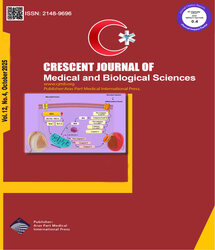

| Original Article | |
| Status of Breast Self-Examination Performance among Women Referring to Health Centers of Tabriz, Iran | |
| Azizeh Farshbaf-Khalili1, Mahnaz Shahnazi1, Leila Vahed2, Leila Javadi3 | |
| 1National Public Health Management Center AND Department of Midwifery, School of Nursing and Midwifery, Tabriz University of Medical Sciences, Tabriz, Iran 2Research Center for Liver and Gastrointestinal Diseases, Tabriz University of Medical Sciences, Tabriz, Iran 3Nutrition Research Center, Tabriz University of Medical Sciences, Tabriz, Iran |
|
|
CJMB 2014; 1: 090-096 Viewed : 4815 times Downloaded : 3811 times. Keywords : Breast Cancer, Breast Self-Examination (BSE), Screening |
|
| Full Text(PDF) | Related Articles | |
| Abstract | |
Objective: Breast cancer is the most common type of cancer and the second principal cause of deaths from
cancer in women. Breast self-examination (BSE) is an inexpensive screening method and is carried out by
women themselves. The purpose of this study was to examine the status of breast self-examination
performance among women referring to health centers of Tabriz, Iran. Materials and Methods: This study was a descriptive/ cross-sectional research carried out on 400 women aged 20-50 years. The samples were recruited randomly from among female clients of health centers in Tabriz. A questionnaire and an observational checklist were used to elicit socio-demographic information and status of BSE performance among women. Content validity was used for validation and Cronbach’s alpha was calculated (0.80) for reliability of instrument. Descriptive and inferential statistics were used to analyze data through SPSS software. Results: The findings of this research showed that only 18.8% of women performed BSE. Among them, 46.67% performed BSE monthly, and 40% at the end of menstruation. The initiation age of BSE in 77% was between 21-30 years of age. It is considerable that 54.7% of them had received no advice on BSE from physicians and midwives. The majority of women did not perform the various steps of BSE. The quality of this screening was very desirable in 2 (0.5 %), desirable in 5 (1.3%), average in 19 (4.8%), undesirable in 36 (9%), and very undesirable in 338 (84.5%) women. Chi-square test showed a significant relationship between the quality of BSE performance and level of education, employment, breastfeeding quality, and family history of breast cancer (P < 0.05). Conclusion: The findings showed that the status of BSE performance was very poor. Therefore, to encourage women to use BSE correctly and regularly, education programs should be performed through various media including television, radio, and leaflets. The role of Health personnel in this field is very important. |
Cite By, Google Scholar
Google Scholar
PubMed
Online Submission System
 CJMB ENDNOTE ® Style
CJMB ENDNOTE ® Style
 Tutorials
Tutorials
 Publication Charge
Medical and Biological Research Center
About Journal
Publication Charge
Medical and Biological Research Center
About Journal
Aras Part Medical International Press Editor-in-Chief
Arash Khaki
Deputy Editor
Zafer Akan

















